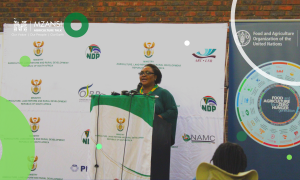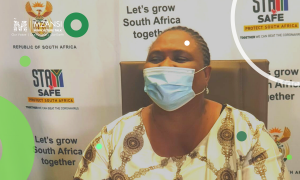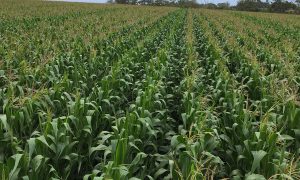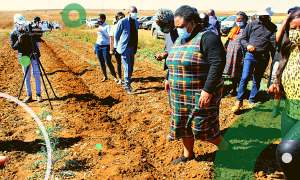2019 has been a tumultuous year for the agricultural sector. The year got off to a tough test with the Eskom electricity crisis and the lack of investment overtime on our economy, thus making agriculture equally facing the same challenge.
Infrastructure that supports agriculture such as roads, ports and rail needs serious upgrading. The government allocated R1.8 billion for the implementation of 262 priority land-reform projects over the next three years, and the R3.7 billion to assist emerging farmers seeking to acquire land to farm.

The devil is in the detail as implementation has been a challenge. This includes a clear programme for the implementation of the blended finance model by the Landbank. The outbreak of the Foot and Mouth Disease has elevated the importance of biosecurity and the allocation to beef up laboratories, and development of vaccines is a positive step. The Minister of finance Tito Mboweni made a R456 million provision for the employment of newly graduated veterinarians within rural areas as part of their compulsory community service. There is however no clear mention of the current drought affecting parts of the North West, Free State, and Northern Cape and this is a missed opportunity. Overall, positive budget from an agriculture perspective, but we need to closely watch implementation.
According to FNB’s agricultural economist Paul Makube, the South African agricultural sector has been facing severe headwinds over the past few years. It came in the form of policy uncertainty, drought in large parts of the country, devastating disease outbreaks, infrastructure constraints and persistent non-tariff barriers and other trade-related problems. However, the industry is learning to dance with the wind, rather than fighting it. It remains resilient despite these major challenges and limitations.
The sector’s Gross Domestic Product (GDP) contribution since the 70’s has been declining consistently from around 8.9% in 1975 to 2.6% in 2017. This is not because agriculture has not been performing; it is just that other sectors in the economy have been performing better. The gross value of agricultural production was close to R267bn in the 2016-’17 financial years. Livestock contributed R127bn (47%), horticulture R74bn (28%) and field crops such as maize, wheat, sunflower seed and soya-beans represented 25% (R66bn) of total agricultural production. In March 2019, food inflation remained subdued at around 2.3%. However, cost pressures (higher fuel prices and electricity tariffs), and concerns about early frost in the maize producing areas may impact inflation negatively.
Last year the country, and particularly the agricultural sector, experienced a year of disaster and misfortune. According to the Agricultural Business Chamber of South Africa (Agbiz), farmers were despondent. Land reform (expropriation without compensation), climate variability, policy uncertainty and the listeria crisis knocked investor and business confidence.

The pork industry experienced the greatest challenge in its history last year. A listeria outbreak killing more than 200 people was followed by an outbreak of African Swine Fever, a severe haemorrhagic disease of pigs, in the Northern Cape. It shattered the industry’s supply chain. During the listeria crisis some producers were losing R1.2m per day. According to the South African Pork Producers’ Organisation (Sappo), the price of pork came down from R28/kg (some farmers were receiving R36/kg) to R10/kg in some instances. This resulted in several smaller farmers to exit the industry.
South Africa is highly stressed in terms of its water resources. For the past six years the country has been plagued by drought in one part or the other. Besides the drought the mining sector has been encroaching and good arable land is being lost for farming. The country is facing increased water pollution which will impact on our food exports if we cannot meet export requirements for minimal residues in our produce.
The destruction of our wetlands is another major headwind blowing across the country. Agricultural activities, amongst others, severely affected and dramatically altered South Africa’s landscapes over the past few centuries – as stated by the department of environmental affairs. Studies in several areas have suggested that between 35% and 60% of our wetlands have already been lost or severely degraded.
According to the South African Weather service recent rains in some parts of the country have renewed hope of a normal season after weeks of heat, dryness and decreasing dam levels. While the overall dam levels for the country remain above 60% at 62% full during the week ended 21 October 2019, some provinces such as Gauteng faced water restrictions due to higher temperatures and the decline in water levels in critical dams. Water levels in the Vaal dam, a major supplier to Gauteng, dropped to 49.6% full, relative to 85.7% last year.
The situation is compounded by the closure of the Lesotho Highlands Water tunnel for maintenance until the end of November and the fact that the Katse and Mohale dams reached a record low of 13.6% and 32.7% respectively. In contrast, the Sterkfontein dam is sitting at good levels of 91.5% full, relative to the 94.4% achieved during the same period last year. Elsewhere, slight rains in Mpumalanga still bode well for the season as the planting window has already opened from 01 October. The province has received near-normal rainfall during the last three months with September alone being above-normal. This bodes well for summer grains and oilseeds as the planting window is from the 1st of October and ending 15 November and 10 December respectively for the cold and high temperate regions.

Although all provinces are currently above 50% full, with the lowest being Limpopo (LP) and the Eastern Cape (EC) at 51.6% and 50.5% respectively, some critical dams for irrigation such as the Middle-Letaba and Tzaneen are extremely low at 3.3% and 6.8% respectively and good rains are needed urgently to salvage the situation. Further, 50% of dams in LP have reached a level below 50% full, while 11 dams in the EC are lower than 20% with four already empty. The province’s two major dams, Darlington and the Kouga, have decreased further week on week (w/w) and still below the 50% mark at 36.3% and 36.6% respectively full.
The latest assessment of the rain for the three-month period from July to September 2019 shows a weak start to the 2019/20 crop season. The period was characterized by below-normal rainfall for the country, but a few isolated areas received near-normal rainfall except over the Free State and Gauteng according to charts from the South African Weather Service (SAWS). The rest of the country is still waiting for decent rains that would ensure a good crop but also improve pasture conditions for livestock and alleviate pressure on irrigated and dryland fruit and vegetables.
Drought conditions persist in some areas of the country – parts of the Northwest, the Northern and Eastern Cape provinces where livestock turnoff has been high. Except for the Pongolapoort and the Vaal, the country’s top 10 dams by capacity were above 60% full, with the Theewaterskloof and Vanderkloof dams reaching 69.3% and 80.1% full respectively. In the WC, citrus supporting dams that reached good levels were Berg River, Buffelsjags, and Clanwilliam at 99.4%, 98.6% and 80% full, respectively. The Brandvlei dam was however closer to the 50% level at 53.8% full.
The short to medium term rainfall outlook still indicates that we have a long way to go for the new crop season. The rainfall forecast for the next two weeks shows rainfall prospects for the interior provinces of FS, NW, GP, LP and MP in the region of 18mm to 35mm of rain. Light showers are also expected for the coastal areas of the Western Cape, and KZN.
It is still a long way into the summer rainfall season and we hope for the rains to materialize and help break the drought particularly in the Northern Cape. Hopefully 2020 will usher in renewed hope and the betterment of the bumper crop season and a spike in the performance of the sector.
Collen Lemawane
Author and Television Business news Anchor
He writes in his personal capacity.
__________
Disclaimer. The views and opinions expressed in this article are those of the author. They do not purport to reflect the opinions or views of Mzansi Agriculture Talk or its members.




















